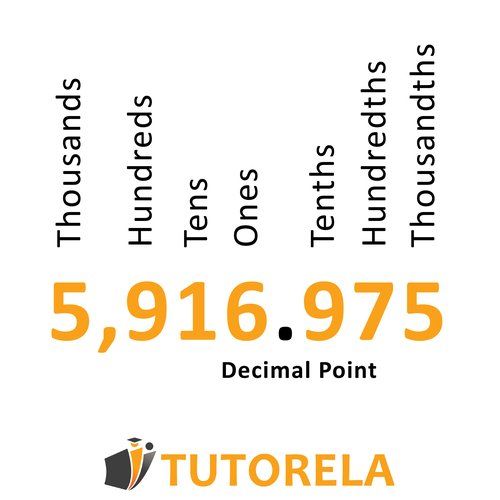The decimal structure divides the number by positions accordingly:
ones, tens, hundreds, thousands, and ten thousands.
For example, in the number
ones, tens, hundreds, thousands, and ten thousands.

The decimal structure divides the number by positions accordingly:
ones, tens, hundreds, thousands, and ten thousands.
For example, in the number
ones, tens, hundreds, thousands, and ten thousands.

A thousands units is represented by the cube below:
Which number is represented by the cubes below?
The decimal structure divides each digit into its group as follows:
ones, tens, hundreds, thousands, ten thousands
Each digit represents a group according to its position. For example, in the number
is in the ones place
is in the tens place
is in the hundreds place
is in the thousands place
and is in the ten thousands place.
In other words, we can say that in the number there are:
ones, tens, hundreds, 4 thousands, and ten thousands.
If we're asked what the value of each digit is, we'll need to multiply the digit by its corresponding place value. That is:
The value of the digit is
We multiplied by because is in the ones place and represents ones.
The value of the digit is
We multiplied by because is in the tens place and represents tens.
The value of the digit is
We multiplied by because is in the hundreds place and represents hundreds.
The value of the digit is
We multiplied by because is in the thousands place - represents thousands.
The value of the digit is
We multiplied by because is in the ten thousands place and represents ten thousands.
Interesting fact!
If we multiply each digit by its place value and add all the products, we obtain the number itself!
Let's observe –
Fascinating Question -
We established that the digit is in the tens place and its value is because
Can we remove it from the number?
The answer is absolutely not!
If we remove the digit from the number, we'll obtain the number which is a completely different number from our original number.
So why is the there at all?
The is holding the place for tens in the original number.
For example, if this number represents a collection of marbles and we want to add another marbles, the digit is what kept the place for these marbles, and after we add them to the collection, we'll obtain the number: .
And now let's practice!
Before you is the number
Questions:
Answers:
Another exercise:
Before you is the number
Questions:
Answers:
A thousand units is represented by a cube as shown below:
What number do the cubes below represent?
A thousand units is represented by a cube as shown below:
What number is represented by the cubes below?
A thousand units is represented by a cube, as shown below:
What number is represented by the cubes below?
A thousands units is represented by the cube below:
Which number is represented by the cubes below?
To solve this problem, we need to calculate the number of units represented by the provided cube diagrams.
Let's follow these steps:
Now, proceeding with the solution:
Step 1: The diagram shows 2 large cubes.
Step 2: Since each cube represents 1000 units, we multiply:
Therefore, the cubes represent a total of 2000 units.
Thus, the number represented by the cubes is .
A thousand units is represented by a cube as shown below:
What number is represented by the cubes below?
To solve this problem, we'll follow these steps:
Step 1: Identify the number of cubes in the representation.
Step 2: Calculate the total number represented by multiplying the number of cubes by 1,000.
Step 3: Match the result with the provided options.
Let's work through these steps:
Step 1: Counting the Cubes
The diagram shows a total of 6 cubes arranged in a 2-layer grid. This can be verified by counting each cube distinctly in the grid shown.
Step 2: Calculate the Total Number
Each cube stands for 1,000 units. Therefore, the total number represented by 6 cubes is:
Step 3: Matching the Result
Out of the provided options, this matches with choice number 4: .
Therefore, the number represented by the cubes is .
Choose a number greater than 1029 whose thousandth digit is 4 less than its units digit.
To solve this problem, we will evaluate each choice to find the number where the thousandth digit is 4 less than its units digit, and the entire number is greater than 1029.
Choice 1:
Thousandth digit is 1, unit digit is 7. The difference is , which does not satisfy the condition (needs to be 4).
Choice 2:
This does not meet the requirement of being greater than 1029.
Choice 3:
Thousandth digit is 1, unit digit is 5. The difference is , which meets the condition. However, is not greater than .
Choice 4:
Thousandth digit is 1, unit digit is 5. The difference is , and the number is greater than . This satisfies all conditions.
Therefore, among the given options, the correctly chosen number is .
Which number has the same thousands digit and tens digit?
To solve the problem, we will examine each number given and evaluate the digits in the thousands and tens places:
Based on the analysis above, the only number in which the thousands digit is the same as the tens digit is .
Therefore, the solution to the problem is .
Which number has a thousands digit of 4 and a hundreds digit that is smaller than its thousands digit?
To solve this problem, let's start by considering the criteria:
Given these constraints, let's consider the provided choices:
Therefore, the number that meets all the conditions is .